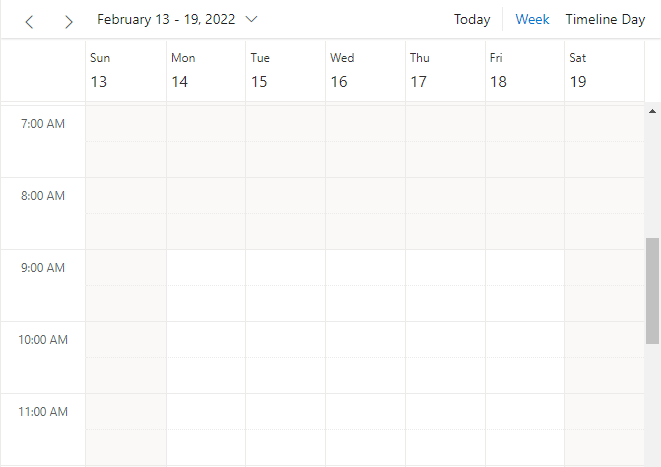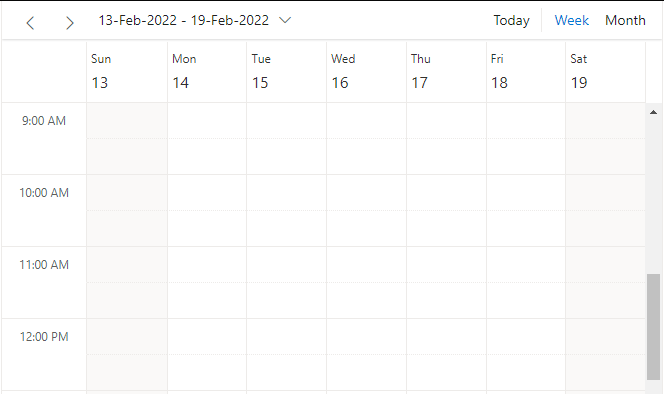Getting Started with ASP.NET Core Schedule Control
3 Nov 20258 minutes to read
This section briefly explains about how to include ASP.NET Core Schedule control in your ASP.NET Core application using Visual Studio.
Ready to streamline your Syncfusion® ASP.NET Core development? Discover the full potential of Syncfusion® ASP.NET Core controls with Syncfusion® AI Coding Assistant. Effortlessly integrate, configure, and enhance your projects with intelligent, context-aware code suggestions, streamlined setups, and real-time insights—all seamlessly integrated into your preferred AI-powered IDEs like Visual Studio, Visual Studio Code, Cursor, Syncfusion® CodeStudio and more. Explore Syncfusion® AI Coding Assistant
To get start quickly with ASP.NET Core Scheduler, you can check on this video:
Prerequisites
System requirements for ASP.NET Core controls
Create ASP.NET Core web application with Razor pages
Install ASP.NET Core package in the application
To add ASP.NET Core controls in the application, open the NuGet package manager in Visual Studio (Tools → NuGet Package Manager → Manage NuGet Packages for Solution), search for Syncfusion.EJ2.AspNet.Core and then install it. Alternatively, you can utilize the following package manager command to achieve the same.
Install-Package Syncfusion.EJ2.AspNet.Core -Version 32.1.19NOTE
Syncfusion® ASP.NET Core controls are available in nuget.org. Refer to NuGet packages topic to learn more about installing NuGet packages in various OS environments. The Syncfusion.EJ2.AspNet.Core NuGet package has dependencies, Newtonsoft.Json for JSON serialization and Syncfusion.Licensing for validating Syncfusion® license key.
Add Syncfusion® ASP.NET Core Tag Helper
Open ~/Pages/_ViewImports.cshtml file and import the Syncfusion.EJ2 TagHelper.
@addTagHelper *, Syncfusion.EJ2Add stylesheet and script resources
Here, the theme and script is referred using CDN inside the <head> of ~/Pages/Shared/_Layout.cshtml file as follows,
<head>
...
<!-- Syncfusion ASP.NET Core controls styles -->
<link rel="stylesheet" href="https://cdn.syncfusion.com/ej2/32.1.19/fluent.css" />
<!-- Syncfusion ASP.NET Core controls scripts -->
<script src="https://cdn.syncfusion.com/ej2/32.1.19/dist/ej2.min.js"></script>
</head>NOTE
Checkout the Themes topic to learn different ways (CDN, NPM package, and CRG) to refer styles in ASP.NET Core application, and to have the expected appearance for Syncfusion® ASP.NET Core controls.
NOTE
Checkout the Adding Script Reference topic to learn different approaches for adding script references in your ASP.NET Core application.
Register Syncfusion® Script Manager
Also, register the script manager <ejs-script> at the end of <body> in the ASP.NET Core application as follows.
<body>
...
<!-- Syncfusion ASP.NET Core Script Manager -->
<ejs-scripts></ejs-scripts>
</body>Add ASP.NET Core Schedule control
Now, add the Syncfusion® ASP.NET Core Schedule tag helper in ~/Pages/Index.cshtml page.
<ejs-schedule id="schedule"></ejs-schedule>Press Ctrl+F5 (Windows) or ⌘+F5 (macOS) to run the app. Then, the Syncfusion® ASP.NET Core Schedule control will be rendered in the default web browser.

Populating appointments
To populate an empty Scheduler with appointments, bind the event data to it by assigning the DataSource property under e-schedule-eventsettings tag Helper.
@{
.....
List<AppointmentData> appData = new List<AppointmentData>();
appData.Add(new AppointmentData
{ Id = 1, Subject = "Explosion of Betelgeuse Star", StartTime = new DateTime(2022, 2, 11, 9, 30, 0), EndTime = new DateTime(2022, 2, 11, 11, 0, 0) });
appData.Add(new AppointmentData
{ Id = 2, Subject = "Thule Air Crash Report", StartTime = new DateTime(2022, 2, 12, 12, 0, 0), EndTime = new DateTime(2022, 2, 12, 14, 0, 0) });
appData.Add(new AppointmentData
{ Id = 3, Subject = "Blue Moon Eclipse", StartTime = new DateTime(2022, 2, 13, 9, 30, 0), EndTime = new DateTime(2022, 2, 13, 11, 0, 0) });
appData.Add(new AppointmentData
{ Id = 4, Subject = "Meteor Showers in 2022", StartTime = new DateTime(2022, 2, 14, 13, 0, 0), EndTime = new DateTime(2022, 2, 14, 14, 30, 0) });
appData.Add(new AppointmentData
{ Id = 5, Subject = "Milky Way as Melting pot", StartTime = new DateTime(2022, 2, 15, 12, 0, 0), EndTime = new DateTime(2022, 2, 15, 14, 0, 0) });
}
<ejs-schedule id="schedule" height="550" selectedDate="new DateTime(2022, 2, 15)">
<e-schedule-eventsettings dataSource="appData"></e-schedule-eventsettings>
</ejs-schedule>public class AppointmentData
{
public int Id { get; set; }
public string Subject { get; set; }
public DateTime StartTime { get; set; }
public DateTime EndTime { get; set; }
}
Setting date
Scheduler usually displays the system date as its current date. To change the current date of scheduler with specific date, define the selectedDate property.
@{
.....
List<AppointmentData> appData = new List<AppointmentData>();
appData.Add(new AppointmentData
{ Id = 1, Subject = "Explosion of Betelgeuse Star", StartTime = new DateTime(2022, 2, 11, 9, 30, 0), EndTime = new DateTime(2022, 2, 11, 11, 0, 0) });
appData.Add(new AppointmentData
{ Id = 2, Subject = "Thule Air Crash Report", StartTime = new DateTime(2022, 2, 12, 12, 0, 0), EndTime = new DateTime(2022, 2, 12, 14, 0, 0) });
appData.Add(new AppointmentData
{ Id = 3, Subject = "Blue Moon Eclipse", StartTime = new DateTime(2022, 2, 13, 9, 30, 0), EndTime = new DateTime(2022, 2, 13, 11, 0, 0) });
appData.Add(new AppointmentData
{ Id = 4, Subject = "Meteor Showers in 2022", StartTime = new DateTime(2022, 2, 14, 13, 0, 0), EndTime = new DateTime(2022, 2, 14, 14, 30, 0) });
appData.Add(new AppointmentData
{ Id = 5, Subject = "Milky Way as Melting pot", StartTime = new DateTime(2022, 2, 15, 12, 0, 0), EndTime = new DateTime(2022, 2, 15, 14, 0, 0) });
}
<ejs-schedule id="schedule" height="550" selectedDate="new DateTime(2022, 2, 15)">
<e-schedule-eventsettings dataSource="appData"></e-schedule-eventsettings>
</ejs-schedule>public class AppointmentData
{
public int Id { get; set; }
public string Subject { get; set; }
public DateTime StartTime { get; set; }
public DateTime EndTime { get; set; }
}Specific view
Scheduler displays week view by default. To change the current view, define the applicable view name to the currentView property. The applicable view names are,
- Day
- Week
- WorkWeek
- Month
- Year
- Agenda
- MonthAgenda
- TimelineDay
- TimelineWeek
- TimelineWorkWeek
- TimelineMonth
- TimelineYear
@using Syncfusion.EJ2.Schedule
@{
.....
List<ScheduleView> viewOption = new List<ScheduleView>()
{
new ScheduleView { Option = Syncfusion.EJ2.Schedule.View.Week },
new ScheduleView { Option = Syncfusion.EJ2.Schedule.View.TimelineDay }
};
}
<ejs-schedule id="schedule" height="550" views="viewOption" selectedDate="new DateTime(2022, 2, 15)">
</ejs-schedule>
Individual view customization
Each individual scheduler views can be customized with its own options such as setting different start and end hour on Week and Work Week views, whereas hiding the weekend days on Month view alone. This can be achieved by defining views property to accept the array of object type, where each object depicts the individual view customization.
@using Syncfusion.EJ2.Schedule
@{
.....
List<ScheduleView> viewOption = new List<ScheduleView>()
{
new ScheduleView { Option = Syncfusion.EJ2.Schedule.View.Week, DateFormat = "dd-MMM-yyyy" },
new ScheduleView { Option = Syncfusion.EJ2.Schedule.View.Month, ShowWeekend = false, Readonly = true }
};
}
<ejs-schedule id="schedule" height="550" views="viewOption" selectedDate="new DateTime(2022, 2, 15)">
</ejs-schedule>
NOTE
You can also explore our ASP.NET Core Scheduler example that shows how to use the toolbar buttons to play with Scheduler functionalities.
NOTE